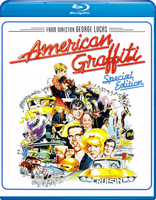American Graffiti Blu-ray Movie
HomeAmerican Graffiti Blu-ray Movie 
Special EditionUniversal Studios | 1973 | 110 min | Rated PG | May 31, 2011
Movie rating
7.8 | / 10 |
Blu-ray rating
| Users | 4.5 | |
| Reviewer | 3.5 | |
| Overall | 3.7 |
Overview
American Graffiti (1973)
A group of teenagers in California's central valley spend one final night after their 1962 high school graduation cruising the strip with their buddies before they pursue their varying goals.
Starring: Richard Dreyfuss, Ron Howard, Paul Le Mat, Charles Martin Smith, Cindy WilliamsDirector: George Lucas
| Drama | Uncertain |
| Period | Uncertain |
| Coming of age | Uncertain |
| Music | Uncertain |
| Romance | Uncertain |
| Teen | Uncertain |
| Comedy | Uncertain |
Specifications
Video
Video codec: VC-1
Video resolution: 1080p
Aspect ratio: 2.36:1
Original aspect ratio: 2.39:1
Audio
English: DTS-HD Master Audio 2.0 (48kHz, 24-bit)
French: DTS Mono
Subtitles
English SDH, French, Spanish
Discs
50GB Blu-ray Disc
Single disc (1 BD)
Bonus View (PiP)
BD-Live
Playback
Region free
Review
Rating summary
| Movie | 3.5 | |
| Video | 3.0 | |
| Audio | 3.5 | |
| Extras | 3.5 | |
| Overall | 3.5 |
American Graffiti Blu-ray Movie Review
Lucas indulges his nostalgia to authentic but indifferent ends...
Reviewed by Kenneth Brown May 12, 2011The first time I sat down and strapped into American Graffiti, I found my brow furrowing and my mind brewing. "It's like George Lucas just threw a couple of kids in some classic cars, drove around town, and shot, wrapped and edited whatever happened," I thought. "They're so far off script it's really beginning to show." As it turns out, that wasn't too far from the truth. With a tight shooting schedule and difficult edit, a production budget topping just $700,000 and a string of boys-will-be-boys antics courtesy of a young cast, American Graffiti was as unpredictable and unruly behind the scenes as the final cut of the film is on screen. But somewhere between the film's at-times pedestrian performances and stilted exchanges, the American Zoetrope co-founder's ode to early '60s cruiser culture takes on an invigorating life all its own. Boys struggle to become men, an oft-forgot era in American history springs to life, and indispensable songs from the likes of Buddy Holly, Chuck Berry and the Platters grab hold of the radio-savvy teenagers and propel them toward an uncertain future. Just don't go into Lucas' sophomore effort expecting a timeless classic.
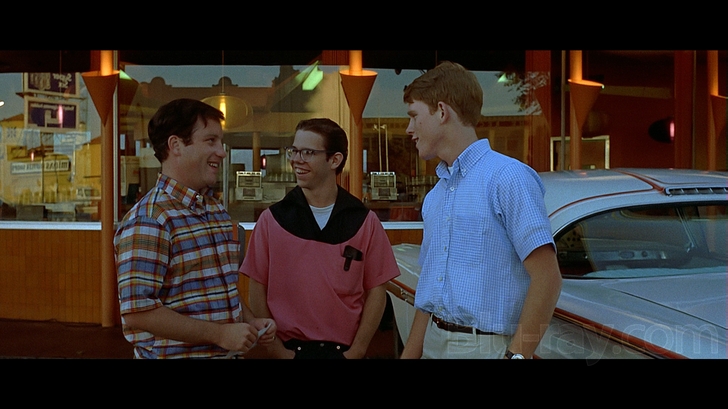
American Graffiti tells the somewhat episodic, coming-of-age tale of four longtime friends and recent high school graduates -- blonde bombshell-smitten Curt Henderson (Richard Dreyfuss, Close Encounters of the Third Kind), college-bound Steve Bolander (future Happy Days mainstay Ron Howard), stiff-lipped cruiser John Milner (Paul Le Mat, Melvin and Howard) and socially inept Terry "The Toad" Fields (Charles Martin Smith, The Untouchables) -- who drive, dance and race their way to morning over the course of a single, life-changing night in Modesto, California. Set in 1962, sandwiched snuggly between the baby boom of the '50s and the social firestorm that would soon erupt as Lyndon Johnson began expanding the scope of the Vietnam War, Lucas' film exudes nostalgia and realism. While an unmistakable yearning for simpler times bleeds through nearly every scene, the director never allows nostalgia to consume him, nor does he don rose-colored glasses. (At least none that he leaves on for very long.) His third act represents a sobering, startlingly poignant commentary on the folly and short-sightedness of youth; so much so that it casts an all-too-revealing light on everything that proceeds it. Curt and his friends may be full of hope and youthful idealism, but the moment the boys face mortality, uncertainty and looming adulthood -- no matter how brief a glimpse each one of them may be afforded -- whatever confidence they once possessed, whatever preconceived notions they might have clung to, are shaken.
Unfortunately, that same sense of purpose doesn't fuel the rest of the film. For the better part of ninety-minutes, Lucas hurries after his cast in a fit of cavalier spontaneity, shooting from the hip like an out-of-breath storm trooper. He not only takes what he's given, he doesn't bother asking them for anything more. (As Harrison Ford, Lucas' once and future gunslinger, explains it in the film's accompanying production documentary, shooting is the director's least favorite part of making a film.) The result is a string of hit-then-miss performances that showcase his young actors' inexperience more than anything else. Dreyfuss and Howard are the most invulnerable to Lucas' strange indifference, acting and reacting with the instinctual ease of the natural talents they already were, but Le Mat, Smith, Ford, Cindy Williams and Mackenzie Phillips have a bit of trouble adapting to his directorial style. While their performances aren't bad by any means, or even average, they sometimes have the wide-eyed stare of actors unaccustomed to their surroundings. In some cases, the Lucas' slice-of-life beats work wonders: Smith's bike troubles, the burst of laughter that comes after Phillips is struck by a water balloon, and Le Mat, Ford and Bo Hopkins' drinking between takes. In other cases, such on-the-fly mishaps serve as all-too-jarring reminders that Lucas' Modesto teens are little more than pen-scribbled characters adrift in an at-times purposefully aimless narrative.
But just when it all begins to take a toll, the sweet smell of nostalgia wafts out of the doors of Mel's Drive-In. Though Lucas, to his credit, keeps a firm grasp on the wheel and his '70s wits about him, his innovative use of music and silence, all-encompassing sound design, and flawless selection of '50s and '60s rock-n-roll classics is the first of many things that help the film weather its more severe storms. It's really hard to despise American Graffiti, if only because the siren songs of some of the greatest musicians and artists of the era are weaved into the fabric of Lucas' distinctly American story. His approximation of 1960s Modesto, viewed through the lens of memories near and dear to his heart, can't be praised enough either. Everything from the cars to the diners and dives ring true, and his costuming, locations and set pieces only intensify the illusion and endear the film to anyone with affection for the time period, history or culture. Thunderbirds, sock hops, greasers, Impalas, real radio broadcast excerpts... there's even an appearance by legendary radio DJ Wolfman Jack himself. American Graffiti isn't George Lucas' finest hour, nor does it feature any career-defining performances from its cast members, many of whom would go on to do bigger and better things just a few years later. But it is a milestone in independent cinema, its director's canon and its actors' lives.
American Graffiti Blu-ray Movie, Video Quality 
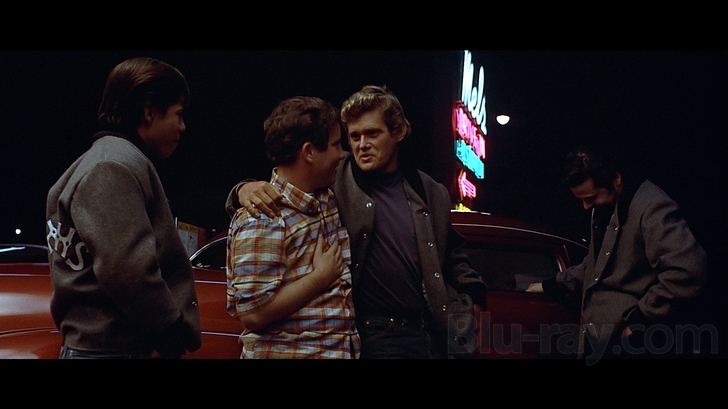
Oh edge enhancement and noise reduction, why do you vex me so? Universal's 1080p/VC-1 transfer would earn resounding praise from me if it weren't for the unsightly, ever-present halos, ringing and smearing that haunt its high definition presentation. Granted, it isn't the worst I've had to endure, not by any stretch of the imagination. But it is apparent and distracting, enough to single-handedly knock my score down quite a bit. I can deal with the darkness and filmic softness that comes to bear on the image; both trace back to Jan D'Alquen and Ron Eveslage's photography and the now-thirty-eight-year-old source. I can even deal with the film's occasionally muted black levels, which also lead back to the source. Lucas's early '60s palette is brimming with bold period colors, coming-of-age primaries, largely lifelike skintones (barring some muddiness) and stable contrast. But detail doesn't reveal as much as it should, even when delineation flounders and the dark of night presses in. Closeups look good, but not outstanding. Textures abound, but aren't refined. Grain permeates the picture, but cloaks ever-present noise reduction. Thankfully, artifacting, aliasing, banding, smearing and other such nonsense is nowhere to be found -- at least none that proves to be significant -- and overzealous DNR and EE are the sole stumbling blocks to be hurdled. Suffice it to say, American Graffiti has never looked better than it does here, but I strongly suspect it could look much better.
American Graffiti Blu-ray Movie, Audio Quality 
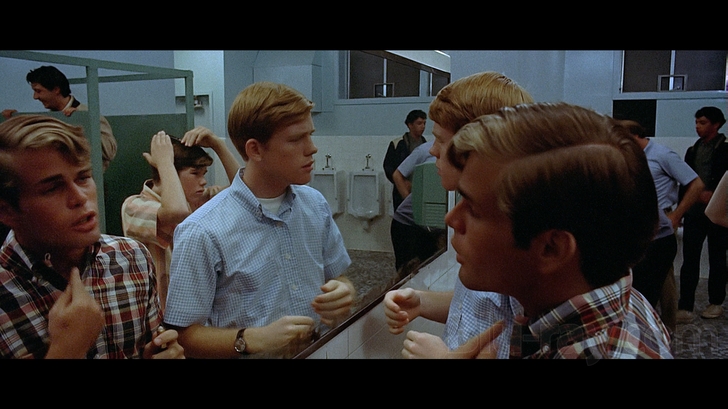
It would be a mistake to dismiss Universal's DTS-HD Master Audio 2.0 mix. At least outright. It may "only" be a two-channel track, but it's a very authentic two-channel track. And while it may seem strange to those who've never watched American Graffiti or experienced its then-groundbreaking sound design, the various background songs sound exactly as Lucas intended. Yes, a meticulously remixed 5.1 surround track could potentially make the director's desired effect that much more immersive, and yes, some additional cleanup work could possibly eliminate some glaring inconsistencies. But to do either would risk compromising the one thing that makes American Graffiti such an interesting cinematic milestone: its ahead-of-its-time, shot-from-the-hip, American Zoetrope aesthetic. Even as is, dialogue is direct and intelligible, effects are distinct (albeit thin) and the lack of LFE oomph and rear speaker support is really the only prevailing disappointment. The quality of the original elements limit the end results, sure. But I doubt those who treasure American Graffiti will expect, or even demand, much more. I, for one, was pleased. Not delighted, mind you, but pleased.
American Graffiti Blu-ray Movie, Special Features and Extras 
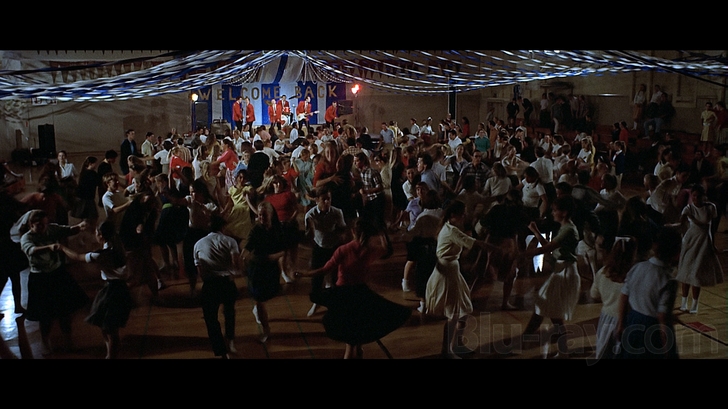
The Blu-ray release of American Graffiti serves up a solid selection of special features, among them a U-Control video commentary with George Lucas, a must-see 78-minute documentary, original screen tests and more. Granted, only the newly recorded video commentary is presented in HD, but fans of the film will find their money has been well spent.
- U-Control Video Commentary (HD): In the first of two newly produced U-Control features, George Lucas sits down for a video commentary in which the oft-criticized director discusses the film, shares anecdotes about the production, and shifts uncomfortably in his seat. Lucas is far more at ease in the disc's primary documentary, "The Making of American Graffiti," and he covers far more ground to greater effect. The Picture-in-Picture aspect of the experience is largely wasted as well. Not only does the commentary disappear at times, Universal doesn't fill the gaps with production photos, behind-the-scenes materials, cast and crew interviews, AG trivia or any of the usual content one might expect from a PiP track. True fans will still enjoy hearing from an older, wiser Lucas, now in the twilight of his career, but I would save this one for last and invest your time in "The Making of American Graffiti" first and foremost.
- The Music of American Graffiti: A second U-Control experience is also available. When engaged, pop-up windows reveal the titles, artist names and original record information of the various songs that grace the film. Unfortunately, users can't turn on both U-Control features at the same time.
- The Making of American Graffiti (SD, 78 minutes): The best extra of the bunch, this seven-part documentary finds Lucas, screenwriting duo Gloria Katz and Willard Huyck, and other key members of the cast and crew at their most candid. Say what you will about Lucas; the man has no misconceptions about his work or career. Here, he elaborates at length on his approach to the material, his handling of the actors, and the film's editing, narrative, music and performances. Everyone from Harrison Ford to Richard Dreyfuss chimes in as well, and the whole of the documentary is, in many ways, far more engrossing than the film itself. I'd even go so far as to say filmfans who loathe American Graffiti will still enjoy every minute of this extensive, refreshingly honest documentary. Segments include "Genesis of the Project," "A Personal Story," "Casting," "Production Begins," "Production Stories," "Post Production" and "Final Words."
- Screen Tests (SD, 23 minutes): A sprawling collection of original screen tests, many of them stilted and awkward, are available with actors Ron Howard, Richard Dreyfuss, Paul Le Mat, Cindy Williams, Mackenzie Phillips and Charles Martin Smith.
- Theatrical Trailer (SD, 3 minutes)
- BD-Live Functionality and News Ticker
- My Scenes Bookmarking
American Graffiti Blu-ray Movie, Overall Score and Recommendation 
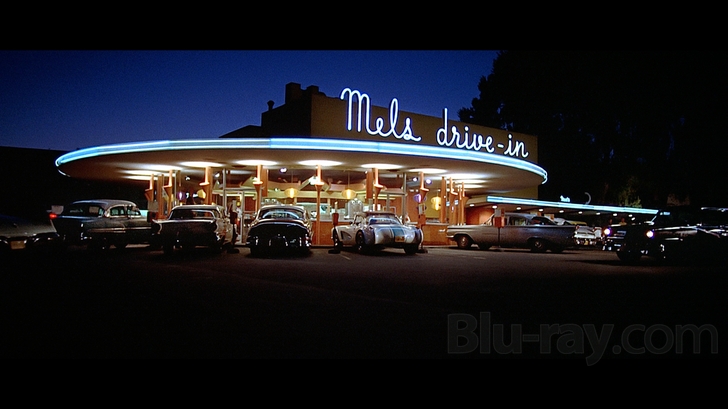
American Graffiti shares little in common with THX 1138 (other than American Zoetrope's independent know-how) and light years away from the original Star Wars trilogy. But it certainly has its charms and holds tremendous nostalgic sway over children of the '50s and teens of the '60s. The music and production design alone make it worth watching. Like the film itself, Universal's Blu-ray release has its share of problems. Overzealous edge enhancement hinders an otherwise impressive video transfer, its DTS-HD Master Audio stereo mix is faithful but inconsistent, and its supplemental package offers plenty of content... just not everything fans might be hoping for. In the end, cruisers will be satisfied, newcomers will shrug their shoulders and everyone else will probably fall somewhere in between.
Other editions
American Graffiti: Other Editions

American Graffiti 4K
50th Anniversary Edition
1973

American Graffiti 4K
50th Anniversary Edition
1973

American Graffiti
Special Edition
1973

American Graffiti
Pop Art
1973

American Graffiti
Universal 100th Anniversary
1973
Similar titles
Similar titles you might also like

Almost Famous 4K
2000

Sing Street
2016

The Last Days of Disco
1998

New York, New York
1977

Lady Bird
2017

Risky Business 4K
Director's Cut and Theatrical Cut
1983

Velvet Goldmine
1998

3 Idiots
2009

Moonrise Kingdom
2012

The Last Picture Show
1971

Immortal Beloved
1994

Dead Poets Society
1989

Little Women
2019

The Artist
2011

An Education
2009

Not Fade Away
2012

Rebel Without a Cause 4K
1955

24 Hour Party People
2002

The Virgin Suicides 4K
1999

The Lords of Flatbush
1974
